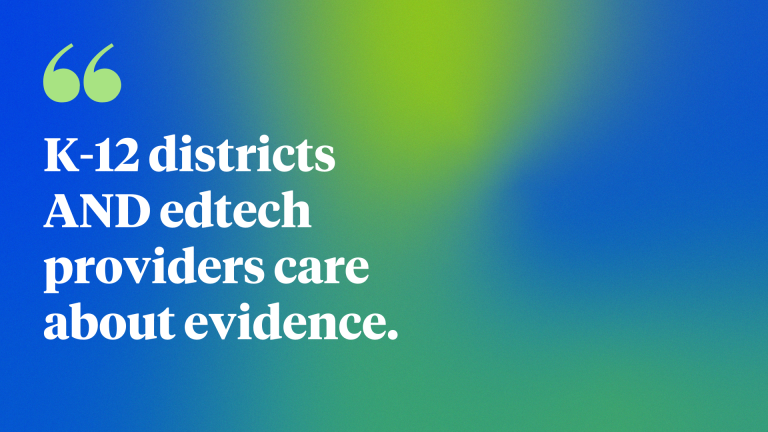
Last week the LearnPlatform by Instructure team had the chance to spend a few days connecting with teachers, administrators, policy makers, and other edtech providers at the annual SXSW EDU conference in Austin, Texas. Austin is a city that thrives on creativity (how else is it going to stay ‘weird’?) and it was easy to feel that energy as thousands of attendees exchanged ideas through sessions, in the expo hall, and most importantly, through casual conversations over coffee, a meal or drinks that just happen at these things.
At a conference of this size there’s never enough time to meet all the incredible leaders or attend all the interesting sessions, but we did our best–and we walked away energized by the work at hand. Here are our top takeaways from SXSW EDU 2023:
K-12 districts AND edtech providers care about evidence.
Oftentimes there is an ‘us vs. them’ mentality between K-12 districts and edtech providers. But the reality is, both are working on (and care deeply about) similar problems. We had the opportunity to talk to numerous district administrators and classroom teachers this week as well as edtech providers, from founders at brand new start-ups to executives at established companies.
Although the specifics and day-to-day tactics for these groups are very different, the underlying themes are strikingly similar. They all have one core question–what’s actually working for our students? The only way we can answer that question is through research and evidence built through true partnerships between educators and students using online solutions and the edtech companies building them.
Edtech providers of all sizes need evidence–even start-ups.
The best educators are innovative. COVID-19 required innovation and all educators rose to the challenge, pivoting almost overnight to virtual instruction and doing everything in their power to keep students engaged and learning in the midst of deeply challenging circumstances. During the pandemic, this often meant trying any and all new online tools that looked promising.
Now, with students back in classrooms and budgets tightening, administrators are making concerted efforts to be more selective in their adoption of edtech but that doesn’t mean the spirit of innovation is gone. Classroom teachers are still enthusiastic to help their students benefit from the latest and greatest solutions. However, the past several years have made education consumers savvier. Educators are demanding that edtech providers document and share research behind their products and offer implementation guidance to use those products to maximum benefit. This means that building a solid evidence base is key from the earliest stages of business growth and needs to be viewed as ongoing.
Interested in the current state of edtech evidence? Check out our 2023 Mid-Year EdTech Evidence Infographic.
There is room for growth in understanding the ESSA evidence levels.
The Every Student Succeeds Act (ESSA) evidence-based levels have guided federal funding of edtech tools since the bill was passed in 2016. However, enforcement of those guidelines has taken time for educators to digest and adopt. And the simple truth is, it’s complicated. ESSA currently lays out four levels of evidence and solutions must achieve a minimum of ESSA Level IV to be eligible for federal dollars.
The nuances of those different levels though can be very complicated, especially for educators without a formal research background. The idea of research as an ongoing, iterative process (as the ESSA framework describes it) can also be daunting for both districts and edtech providers. That’s exactly why LearnPlatform developed our practical, classroom-centric rapid-cycle evaluation model, and why we’re on a mission to spread the word about what ESSA-aligned evidence actually means. Stay tuned for an upcoming blog post on understanding the ESSA evidence levels!
Evidence is foundational to equity–and edtech providers need to confront the data.
Diversity, equity and inclusion (DEI) was unmistakably the biggest theme of this year’s conference. Educators are on the front lines of understanding the widening gaps in opportunity that today’s learners face, and what the long-term ramifications of those gaps can be. The need to work towards more equitable education opportunities for ALL learners is undisputed but the best way to get there is a matter of endless debate. We often talk about figuring out what’s working but oftentimes figuring out what isn’t working is just as valuable.
Unfortunately, both districts and providers are very hesitant to share the negative outcomes, regardless of how valuable they are. As our evidence trailblazer partner, Stephanie Myers at Reading Horizons put it so well, we need to confront the data. Negative or inconclusive results can teach just as much as positive results. To truly work towards equity, we need to acknowledge less-than-spectacular results and use them as a starting point for productive conversations about product design and implementation approaches. All research is productive and can move us toward achieving common goals.
It was a jam-packed four days, but we left energized for what’s to come. Evidence-based edtech is just taking flight. Connect with a member of our team to get started on building evidence for your district or edtech solution.
Related Content
 The Power of Formative Assessment 7 Ways It Can Benefit Learners.png
The Power of Formative Assessment 7 Ways It Can Benefit Learners.pngBlogs
 formative_assessment_1.png
formative_assessment_1.pngBlogs
 integrated-learning-systems.jpg
integrated-learning-systems.jpgBlogs